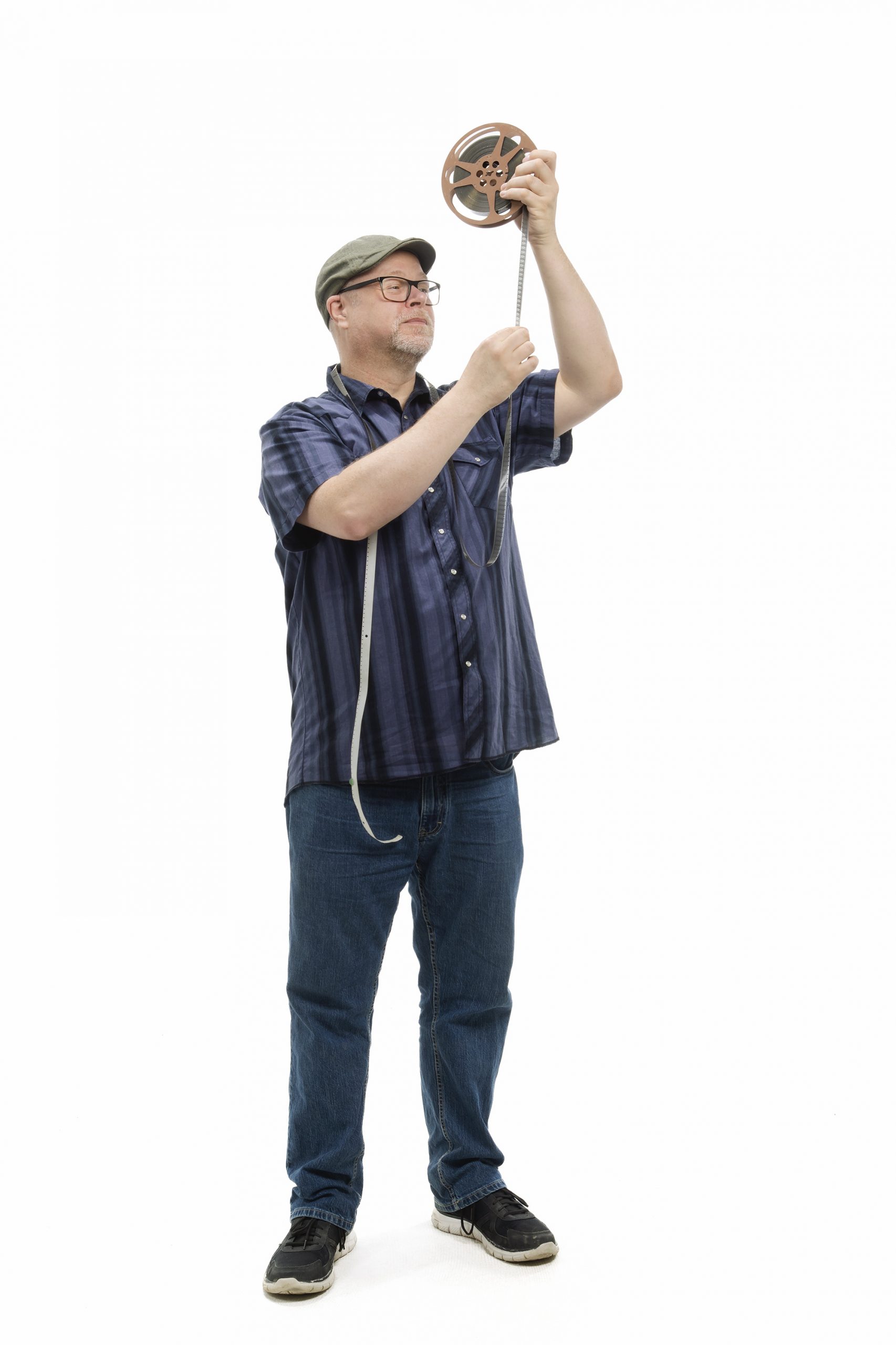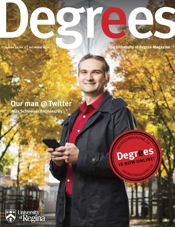Spot Light

Meet former Department of Film student Cory Rennebohm — the film rescuer.
- Why did you pursue a film degree?
- I tend to be a visual person and thinker, I also gravitate towards activities and projects that have results I can physically see or touch. I like using tools and technology to achieve those results. Film allowed me to take my ideas and using cameras and editing equipment, translate them into something I could share with other people.
- What was one of the valuable skills you learned at film school?
- The most valuable skills I learned at film school revolve around the process of editing, how the machines worked, how to splice film and video, how to improve the images you are working on. As with all technology, it changes so rapidly. When I was at school we worked almost exclusively on analog equipment. Digital editing and video was in its infancy so the equipment and at the time the University had very little of it. The machines I learned to edit on have long since moved on, but that experience on those machines became very valuable when I started working at Film Rescue.
- How did you come to get the job at Film Rescue?
- Like a lot of people, when I left Uuniversity. I had student loans to payoff so I took a job working in healthcare as a means of making some money to pay off my loans. I ended up working in health care while attending school and for several years after. When I met my wife and we wanted to settle down we moved to Indian Head, SK to be closer to our families. My friend Greg Miller moved to town around the same time. He had been working in a film lab in Toronto, developing movie and photographic film and as a hobby started working with old and expired films to see if he could produce images from them, to "rescue" them. Word of mouth about Greg's hobby spread and eventually requests were coming in all the time and he saw an opportunity to turn his hobby into a business. Greg had family in the nearby town of Wolseley and so when it came time to set up his lab he decided to do it somewhere closer to his family where he could run his new business without the crazy overhead of trying to run a new business in Toronto. After a couple of years in operation in Indian Head, Film Rescue began the process of merging the old with the new by integrating digital scanning into our movie film department. Greg was aware of my education in film from the U or R so one day, out of the blue he called and asked if I would be interested in coming in to work with him to convert the movie transfer department to digital. I immediately said I would and within a month or so he brought me on full-time to run the film and video transfer department of Film Rescue.
- What do you for Film Rescue?
- I am the Senior Film Transfer Technician at Film Rescue. Basically it is my job to oversee any of the motion transfers that come into Film Rescue, whether that be previously developed films, films we are processing, or video. As well I provide our clients with support and information about the services we offer, I offer back end support on the work we have done for them etc. I also personally operate our high end scanning equipment and I edit and attempt to optimize the images we recover from the films we are sent.
- What’s the oldest film that you got an image from? What was it of?
- Oddly, the oldest film we ever developed and were able to recover images from was from a film that expired in 1908. I say oddly because although the film was extremely old, the images were not. In fact they were modern images that we shot ourselves as part of a test for a project we were working on that would have seen us attempting to develop another similar film that had been frozen in ice for over 100 years. Unfortunately, although we were able to produce images from the test film, complications with the group trying to recover the original film from the ice caused the project to be shelved. That said we regularly have developed film from the late 1910s and 1920s. Personally I recently scanned some films shot on 9.5mm pathe film from the 1920s. As with most of our films they quite often are family films, and this one was no exception. It was a family at the beach in full length old time bathing suits, splashing in the water and playing in the sand. I love seeing these old films because they always help history feel more accessible and palpable.
- What is it about your job that gives you the most satisfaction?
- Unlike most film labs, Film Rescue is a special place to work in that a large portion of the people we are working for have no idea what they are sending to us to be developed or scanned. They quite often have found films when they are going through the belongings of a loved one who has passed away, or they have found something they themselves had shot years ago and forgotten about. When we successfully develop these films we are essentially opening a time capsule of moments from the lives and histories of these people’s families and then giving those moments back to them. Sometimes they are moments they remember, sometimes they are things they have never seen. We regularly receive emails or phone calls from people overcome with emotion thanking us for giving them new images of a lost love one, or a memory of a moment with them they thought was gone. There is nothing more satisfying then knowing that you played a part in giving someone back a treasure they thought was lost.
- What are some of the more unusual images/motion pictures that you have uncovered?
- Well that depends what you mean by unusual. If you mean unusual, as in interesting I have seen a lot over the years. Once of the more unusual films I have seen was a recording of a sermon from one of the Peoples Temple Church congregations in California, The church that was founded by infamous cult leader Jim Jones. It was found in the attic of the old church building and was sent in by the California historical society. It was a sound Super 8 film and showed the reverend who was conducting the sermon railing and ranting about the government and Bobby Kennedy. Just recently I was lucky enough to work on a large number of films that came from a film maker that is working on a documentary about the first major blues festival in North America. The films were all 16mm footage that had been sitting in a basement since 1970 and contained both performances and candid footage of several famous blues musicians like John Lee Hooker, Buddy Guy, Johnny Winter, and several others. We also recently began working on a large undeveloped archive of photographic film from a customer in Boston who was an Emcee at a club there called The Tea Party. His photographs were of several artists and celebrities that performed or attended the club, people like Mick Jagger, Ron Wood, Rod Stewart and Faye Dunaway. We've also done work for several presidential libraries in the United States including the Johnson Presidential Library, which saw us developing images from Lady Bird Johnson's personal camera. The images were shot during her time with him on the campaign trail in 1964. If you ask me again in about 6 months I should have another interesting story for you about a project we are working on with the New York Times but right now what we are doing for them is top secret.
- What is your favourite rescued images/film?
- I have seen so many interesting, cool images over the years of working here that it's hard to narrow it down, but if I had to pick a favourite it would be from a client we had about 8 or 9 years ago. that was born in Belgium. He was an older gentleman in his 70's and the footage he brought in was from his father’s camera. The gentleman stood beside me as I scanned the film which contained images from 1944 on the day that the Canadian troops liberated Brussels from the Nazi army. There were planes overhead, people dancing in the streets cheering as Canadian soldiers marched down the streets and rode through in jeeps. Among all this chaos and joy was a woman holding a small boy who had grown up to become the gentleman now standing over my shoulder. It was probably the most memorable day I have ever had since I started doing this job.
- What keeps you interested in your job?
- The thing that keeps me interested in this job is that this job is always interesting. Whether its photographic film or movie film, all of us here at Film Rescue get to experience moments in time through the eyes of the people who were there. It could be something as simple as a birthday party or as historic as the launch of the first mission to the moon, it's all part of someone's story and I get to be one of the people who cracks open the time capsules those moments are hidden in. How could that ever get boring?






